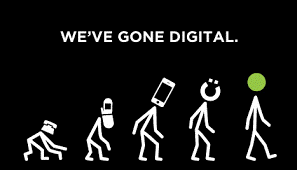…. But we’re still human.
This is part of a series of on de-digitising Digital Transformation.
De-digitising Digital Transformation
Let me rephrase a relevant message from the World Economic Forum, Davos, Jan 2018:
Get ready for an even more intense wave of corporate transformation – leaders attending the Davos event are seeking new engines of growth. Digital may be the enabler, the conduit for business change, while transformation is a strategic mission, and ultimately a human one.
Is the human side well understood? In all the talk of digital transformation (DX) it’s often reported that the tech side, digital, becomes the focus and business sponsors can sometimes drift off, leaving it to IT.
Re-think: Seeing the goal as organisation redesign and culture development sets the framework where it should be. When I talk to organisations now about digital projects one of my first questions is “How are you redesigning your organisation to be properly digital?” and then “How are you handling the human side, the engagement, for successful deployment?”
A starting point:
- Rebuilding the technology probably is required, and if so, can’t be deferred or short-delivered
- Redesigning the organisation is essential – for new accountabilities, for getting change done
- Rethinking customer value is just as essential – your competitors are doing that 24×7
Since we’re talking competitors …. your investor-funded start-up competition is going bullseye after your customers with a flat non-hierarchical team of motivated people, a legacy-free tech platform that is purpose-built for speed, agility and good CX, and a completely new value offer. Their operations are optimised, 100% on-target, and their commitment to new forms of CX is embedded in their DNA.
Digital Transformation has become so many things, and partly because to stay competitive it has to be. It’s an IoT adoption; a mobile customer sales engagement app; new communications channels with social media tools; a cloud-based collaboration; a txt messaging customer service tool, and many more.
Precursors for DX – projects that will be or should be underway:
- Upgrade IT infrastructure & platforms for flexibility, agility
- Improve operational ability to adapt to change
- Accelerate innovation as part of culture alignment
Step 1 is almost a housekeeping step albeit an essential one, which takes budget & focus to do well but is an enabler not an outcome. As noted above, these projects can become assumed to be delivering some transformational outcomes, an apparently common mistake.
However it is steps 2 & 3 that will lead to redefining CX and organisational outcome, and steps that should be owned by business team, not by an IT or tech deployment team.
Those of us with years of project experience know it’s not about the tech, it’s all about the human side of deployment, the onboarding, the exec commitment, the training, and consistent business ownership of the result, which means organisation or process change when needed, gets done. How to keep the focus on the transformation, rather than the tech work, to de-digitise digital transformation?
- De-digitise your digital transformation (otherwise called RTM by IT geeks)
- De-digitise, means be ready for the Millennial digital-born generation who treat tech as a consumable, a given, and expect intuitive mobile-centric device-agnostic self-configurable simplicity.
- De-digitise means simplify. If things are getting complex, it’s not the tech it’s processes – complexity loves a process, while good CX hates complexity.
- De-digitise means focus on people, how they will engage, and on human-centred design
While tech platforms that are agile, scalable, automated and CX-smart are essential, the digitally competitive organisation is equally a human & cultural shift, and that includes your customers as much as your people. The poster-book examples of game changing digital launches – e.g. Uber, Netflix, AirBnb – along with the whole mobile app paradigm are as much about behaviour change as clever technology.
Planning to Succeed
A leading success measure will be customer satisfaction, along with the top benefits as reported in a number of industry surveys available (Forrester Research, Gartner, McKinsey, etc.)
- Increased market share
- More customer engagement in digital channels
- Improved employee morale
- Faster time-to-market
- More, and more valuable, innovation
We could add employee engagement as an essential factor which mirrors all the needed activity – senior exec commitment, intelligent visioning, aligning people with the work programme, seeking and using feedback, setting clear goals. And, ensuring CX based on human design is understood as a critical change driver.
When the relevant choices of these are used to frame the way outcomes are defined and measured, you’re on your way to keeping business properly in charge of the result.
In my next articles we’ll look closer at the change factors – obstacles, challenges, common observations & what is found work.






